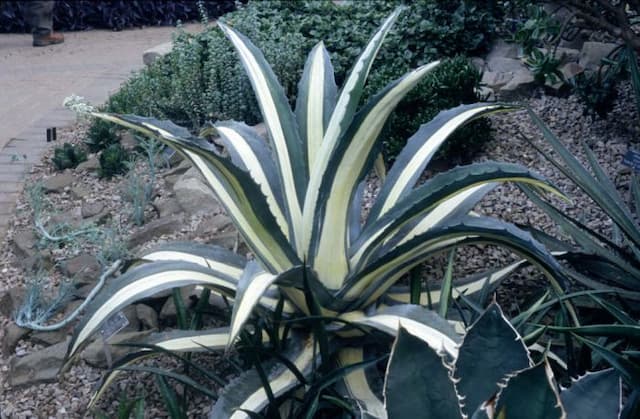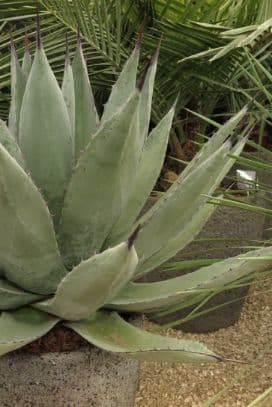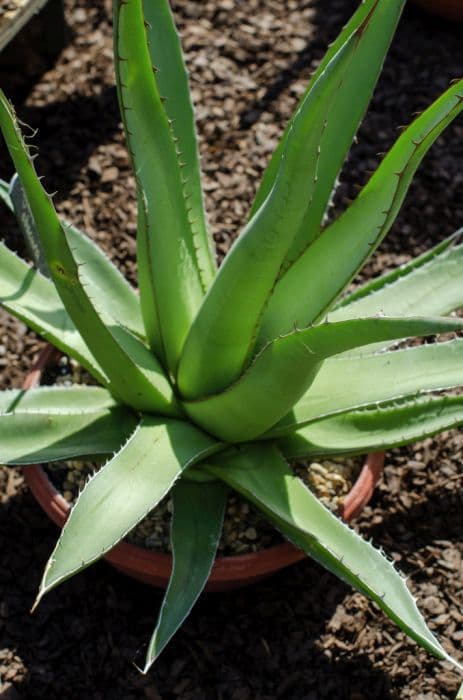Hosta Hosta 'Restless Sea'

ABOUT
Hosta 'Restless Sea' is a captivating plant characterized by its intricate foliage. The leaves are a mesmerizing blend of blue and green hues, with a unique tactile quality featuring pronounced wavy edges that mimic the ebb and flow of ocean tides. This dynamic rippling effect adds a sense of movement, as if the leaves are gently undulating under a sea breeze. Each leaf is substantial and heart-shaped, contributing to a lush and dense appearance. The surface of the leaves exhibits a notable texture, with a slightly puckered or seersucker quality, giving them added depth and visual interest. This textured effect also enhances the interplay of light and shadow across the plant's surface, further emphasizing its wavy contours. Over the growing season, the foliage may undergo subtle color transformations, adjusting to various environmental factors, which can add to the plant's intrigue. The Hosta 'Restless Sea' produces upright flower stalks that rise above this oceanic tapestry of foliage, sporting tubular flowers that attract pollinators like bees and hummingbirds. Though the primary draw is its foliage, these delicate blooms add a softer counterpoint to the Hosta's bold leaves. Hosta 'Restless Sea' creates an immersive experience in the garden, bringing a hint of the aquatic world's serenity and rhythm to the terrestrial landscape through its unique and dynamic leaf structure.
About this plant
 Names
NamesFamily
Asparagaceae
Synonyms
Plantain Lily, Funkia
Common names
Hosta 'Restless Sea'.
 Toxicity
ToxicityTo humans
Hostas are generally not considered toxic to humans; however, it is not advisable to ingest any part of the plant. In rare cases or with individual sensitivities, consuming hostas could potentially cause mild stomach upset, but significant poisoning or serious consequences are unlikely.
To pets
Hostas can be toxic to pets, particularly to dogs and cats, if ingested. The main toxic principle in hostas is saponins, which can cause symptoms such as vomiting, diarrhea, and in severe cases, depression in pets. Pet owners should prevent their animals from eating this plant to avoid these possible consequences.
 Characteristics
CharacteristicsLife cycle
Perennials
Foliage type
Deciduous
Color of leaves
Variegated
Flower color
Lavender
Height
1 foot 2 inches (35 cm)
Spread
2 feet 4 inches (71 cm)
Plant type
Herb
Hardiness zones
3
Native area
Asia
Benefits
 General Benefits
General Benefits- Attractive Foliage: Hostas are known for their beautiful, lush foliage, and 'Restless Sea' offers unique wavy leaves that provide texture to the garden.
- Shade Tolerance: Hostas are excellent for shaded areas where other plants may struggle to grow, making them versatile for garden design.
- Low Maintenance: 'Restless Sea' requires minimal upkeep beyond occasional watering and removal of dead leaves, making it an ideal choice for both novice and experienced gardeners.
- Long-Lived Perennial: Hostas are perennials that come back year after year, offering longevity and reduced replacement costs.
- Slugs Resistance: Some Hosta varieties, such as 'Restless Sea,' are known to be more resistant to slugs compared to other Hostas, reducing the need for pest control.
- Seasonal Interest: Hostas provide visual interest from spring through fall with their foliage, and some even offer delicate flowers that attract pollinators.
- Ground Cover: Hostas can serve as effective ground cover, helping to reduce weed growth and soil erosion in the garden.
- Easy to Divide: As they grow, Hostas can be easily divided to create more plants, which can be shared with friends or used to expand the garden.
 Medical Properties
Medical PropertiesThis plant is not used for medical purposes.
 Air-purifying Qualities
Air-purifying QualitiesThis plant is not specifically known for air purifying qualities.
 Other Uses
Other Uses- Hostas can be used in art projects, such as stamping or printing, where their textured leaves are painted and pressed onto paper or fabric to create natural patterns.
- Their broad leaves can serve as natural molds for concrete garden stepping stones, creating organic shapes and impressions in the finished product.
- Hosta leaves are sometimes used in floral arrangements or centerpieces to provide a lush green backdrop for flowers.
- Hosta plants can be used to create a living fence or privacy screen in the garden due to their dense foliage.
- Garden hobbyists may use dried Hosta leaves in craft projects, such as making wreaths or other decorative items for the home.
- Large Hosta leaves have been used as a natural serving dish for outdoor gatherings, providing an eco-friendly plating option.
- Aquarium enthusiasts sometimes use cleaned Hosta leaves to add a natural element to fish tanks, although they're not aquatic plants.
- Hostas can be planted in containers and used to create mobile shade spots on patios or decks.
- In photography, Hosta plants can be used as a serene and uniform background for macro photography, highlighting the details of smaller subjects.
- Hosta leaves have been utilized by some artists as a canvas for intricate paintings, taking advantage of their large, flat surfaces.
Interesting Facts
 Feng Shui
Feng ShuiThe Hosta is not used in Feng Shui practice.
 Zodiac Sign Compitability
Zodiac Sign CompitabilityThe Hosta is not used in astrology practice.
 Plant Symbolism
Plant Symbolism- Resilience: The undulating foliage of the 'Restless Sea' hosta represents the ability to adapt and persevere through challenges, much like the changing tides of the sea.
- Peace: Hostas are often found in tranquil garden settings, symbolizing a calming presence and a retreat from the busy world.
- Self-care: The need for shade and moisture mirrors the human necessity of taking time for oneself and retreat to rejuvenate.
- Longevity: With its perennial nature and ability to thrive for many years, the hosta signifies long life and endurance.
 Water
WaterHostas require consistent moisture, so it's best to water 'Restless Sea' deeply once a week with about one gallon of water per plant. During hot and dry periods, you may need to water twice a week. Make sure to avoid overhead watering to prevent leaf burn and fungal diseases. Instead, water directly at the base of the plant, allowing the water to reach the roots where it's needed most. During rainy seasons, reduce watering to prevent waterlogging the soil.
 Light
LightHostas, including 'Restless Sea', thrive best in partial to full shade. They can tolerate some morning sun, but should be protected from the harsh afternoon sun to prevent leaf scorch. A spot that receives filtered light or dappled sunlight beneath trees or on the north side of buildings is ideal for these shade-loving perennials.
 Temperature
TemperatureThe 'Restless Sea' Hosta prefers temperatures between 50°F and 80°F for optimal growth. They can withstand temperatures down to about 30°F but should be protected from hard frosts. During the summer, ensure they are kept cool and avoid exposure to temperatures over 90°F, which can stress the plant and cause damage to the foliage.
 Pruning
PruningPruning Hosta 'Restless Sea' involves removing spent flower stalks after blooming to conserve plant energy and improve aesthetics. Also, trim away any damaged or yellowing leaves during the growing season to maintain plant health. The best time for a thorough cleanup is early spring or late fall, but minimal pruning can be done as needed throughout the year.
 Cleaning
CleaningAs needed
 Soil
SoilThe best soil mix for Hosta 'Restless Sea' is loose, well-draining soil rich in organic matter, such as a blend of peat moss, compost, and pine bark. The soil pH should ideally be between 6.0 and 7.5.
 Repotting
RepottingHostas, including 'Restless Sea', don't need frequent repotting and can thrive in the same pot for several years. Repot only when the plant outgrows its container, which is typically every 3-5 years.
 Humidity & Misting
Humidity & MistingHosta 'Restless Sea' prefers moderate humidity levels but is adaptable to a range of conditions. Strive for humidity levels between 50% and 70% for optimal growth.
 Suitable locations
Suitable locationsIndoor
Provide bright, indirect light and keep the soil moist.
Outdoor
Place in partial to full shade, shelter from direct sun.
Hardiness zone
3-8 USDA
 Life cycle
Life cycleHostas, including 'Restless Sea', begin their life cycle with seed germination, although they are often propagated through division of mature plants. After germination or transplantation, they enter a growth phase where they develop their characteristic foliage, with 'Restless Sea' displaying wavy blue-green leaves. Over several years, the hosta reaches maturity and develops a clump-forming habit. The mature plant produces flower stalks in the summer, which are typically tall and bear lavender or white flowers that attract pollinators. After flowering, seeds may be produced, completing the reproductive cycle. Finally, as perennials, hostas die back to the ground in late autumn and enter dormancy during the winter, resuming growth the following spring.
 Propogation
PropogationPropogation time
Spring-Early Summer
Propogation: The Hosta 'Restless Sea', commonly known as Hosta, is typically propagated in the spring or early fall when the plant is not in active growth. The most popular method for propagating Hostas is through division. To propagate by division, firstly, carefully dig up the entire Hosta clump, making sure to minimize root damage. Gently shake the soil from the roots and use a sharp, sterile knife or spade to cut the clump into smaller sections, making sure each division has at least 2-3 shoots and a portion of the root system. Replant these divisions at the same depth they were growing previously and water them thoroughly to establish the new plants. This process allows gardeners to quickly multiply their Hosta plants while preserving the characteristics of 'Restless Sea'.









